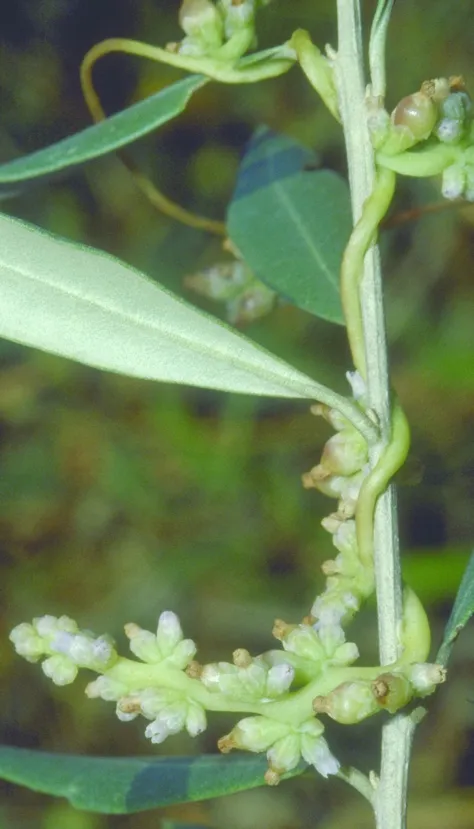One-styled Dodder, Oriental Dodder
Cuscuta monogyna

Cuscuta monogyna once grew in many regions in Israel but its current distribution
is limited to four regions only: the Carmel Coast, southern Golan Heights,
Kinorot Valley and the Bet She’an Valley. According to the Flora Palaestina
it once grew in the following regions as well: the Dead Sea, Lower Jordan
Valley, Hula Valley, Upper Galilee, Lower Galilee, Jezreel Valley, Carmel,
Sharon and Philistian Plain, Judean Foothills and Jerusalem Mountains. According
to the Rotem database, it grew and became extinct in only three regions – the
Sharon, the Jordan Valley and the Dead Sea. The discrepancy between the sources
may be a result of a typographical error or from unfounded data from the
literature. On the Carmel coast, it was found over the last twenty years near
En Hod and near Atlit. In the Bet She'an Valley, it was found in the Avoca salt
Marsh in 1988. In the Kinorot
Valley, it was once quite common in the Ginosar Valley, but has
become very rare. It is still quite common in the Bet Tsayda Valley there it
climbs on Vitex agnus-castus, Ziziphus lotus and others. In 2007,
it was found in Tel Dan in the Hula Valley.
Cuscuta
monogyna grows in valleys in hot areas and attaches itself to
shrubs and trees that grow on deep clay soil. It also grows on ruderal sites
and on cattle grazing sites in low, warm areas.
For the genus – see Cuscuta babylonica.
C.
monogyna belongs to a unique systematic group in the genus Cuscuta,
whose flowers have a single style (other groups - 2). The stems thick and
yellow, while all the other Cuscuta species in Israel have thin usually
whitish-reddish stems (except C.
campestris, whose stems are thin and yellow).
•
In many of the
regions in which Cuscuta
monogyna currently grows or has grown in the past, no rare
species survey was conducted. However, in the regions where a survey was
carried out, there was a drastic reduction or complete destruction of
populations. The species was not found in the Upper Galilee, Jezreel Valley,
Lower Galilee, Carmel, and Sharon regions, where it had been collected before
1960, nor was it located in 1989-1997. For example, the site at the foot of
Mount Tabor, which was once an excellent site for collecting and checking the
species, is now extinct.
•
The total number
of sites known today is four: the species is rare in all areas, except the Bet
Tsayda Valley. There is no available data on the population size (the sites in
question were not included in the rare species survey).
•
The largest C. monogyna population is
mostly in the Bet Tsayda Reserve (not officially declared!); all the other
sites are outside of nature reserves.
All the Cuscuta
monogyna sites in Israel should be mapped, focusing on the
regions where no rare species survey was conducted. The C. monogyna population near Bet HaBek
should be monitored, and attempts should be made to learn the factors
behind the reduction of its national range.
Cuscuta
monogyna has a broad distribution – primarily in the
Mediterranean and Irano-Turanian regions, with penetrations to the southern
Euro-Siberian and Sudanian regions: in the Mediterranean region, it grows in
the Maghreb Countries, France, Greece, Cyprus and Turkey. In the Middle East –
in Syria-Lebanon, Jordan (Ghur), North Egypt, Iraq and Iran. Its distribution
continues eastwards to Pakistan, Afghanistan and Central Asia. In the Euro-Siberian
region it grows in the Black Sea Countries, in Caucasus and in Western Siberia.
In the Sudanian region, it grows in in Ethiopia and southern Pakistan.
Cuscuta
monogyna is a perennial parasitic plant, without leaves,
which was formerly common in seven regions throughout the country (possibly 14),
its distribution is now confined to four regions and it has become a rare
plant. It is a northern peripheral species, growing mainly on shrubs and low
trees in warm alluvial valleys. Currently only 11 populations are known,
compared with tens in the past.
Current Occupancy Map
| 1000 squre meter pixel | 5000 squre meter pixel | 10000 squre meter pixel | |
|---|---|---|---|
| number of observations | 0 | 0 | 0 |
| in total pixels | 0 | 0 | 0 |
| Family | Convolvulaceae |
| Classification | On the near threatened species list |
| Ecosystem | Mediterranean |
| Chorotype | Mediterranean and Irano - Turanian |
| Conservation Site | Bet HaBek in the Bet Tsayda Reserve |
| Rarity |
1
2
6
|
|---|---|
| Vulnerability |
0
3
4
|
| Attractiveness |
0
0
4
|
| Endemism |
0
0
4
|
| Red number |
1
2.6
10
|
| Peripherality | 0 |
| IUCN category | DD EW EX LC CR EN VU NT |
| Threat Definition according to the red book | Near threatened |
 Based on:
Based on:




